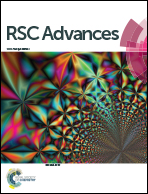Sol–gel synthesis of transition-metal ion conjugated alumina-rich mullite nanocomposites with potential mechanical, dielectric and photoluminescence properties
Abstract
Nanocrystalline mullite have been synthesized from non-stoichiometric alkoxide precursors via sol–gel route with Co2+, Ni2+ and Cu2+ as dopant metal ions. Transition-metal aluminate spinel phases, formed from the reaction between dopant metal ions and dissolved alumina species, introduced prominent colors to the composites after sintering. Interesting colors combined with suitable densification lead these composites to have potential use as ceramic pigments. A comparative Vickers and Knoop hardness have been evaluated in terms of dislocation movement along grain boundaries with highest hardness and Young’s modulus values of ∼8.7 GPa and ∼207 GPa for copper and cobalt incorporated mullite, respectively. Greater porosity of pure mullite results in an unconventionally high dielectric constant of ∼91 whereas larger interfacial polarization is responsible for the varying dielectric response of transition-metal incorporated mullite composites. Formation of oxygen like defects in the composites cause prominent PL bands with highest PL intensity for dopant cobalt ions in mullite matrix.


 Please wait while we load your content...
Please wait while we load your content...